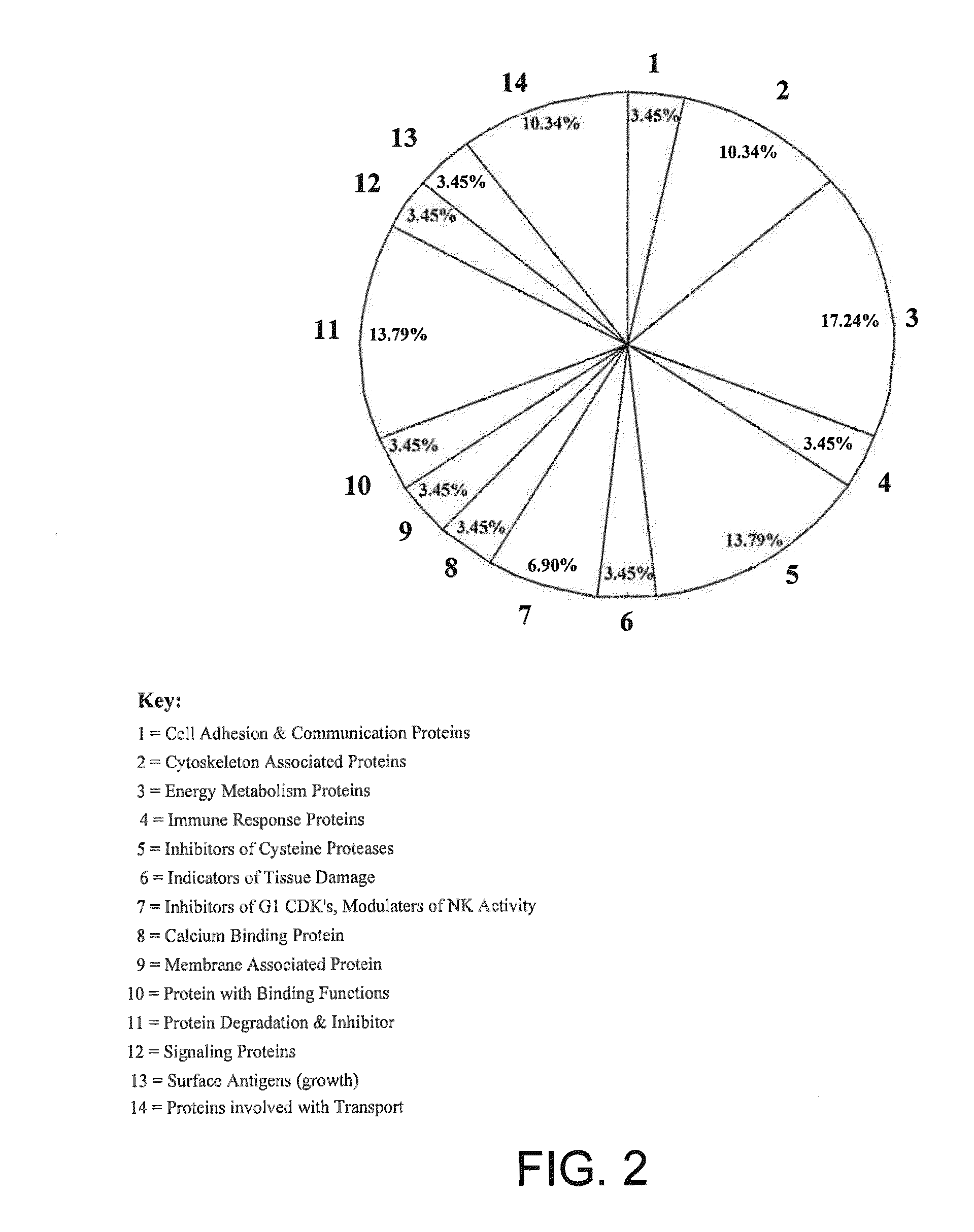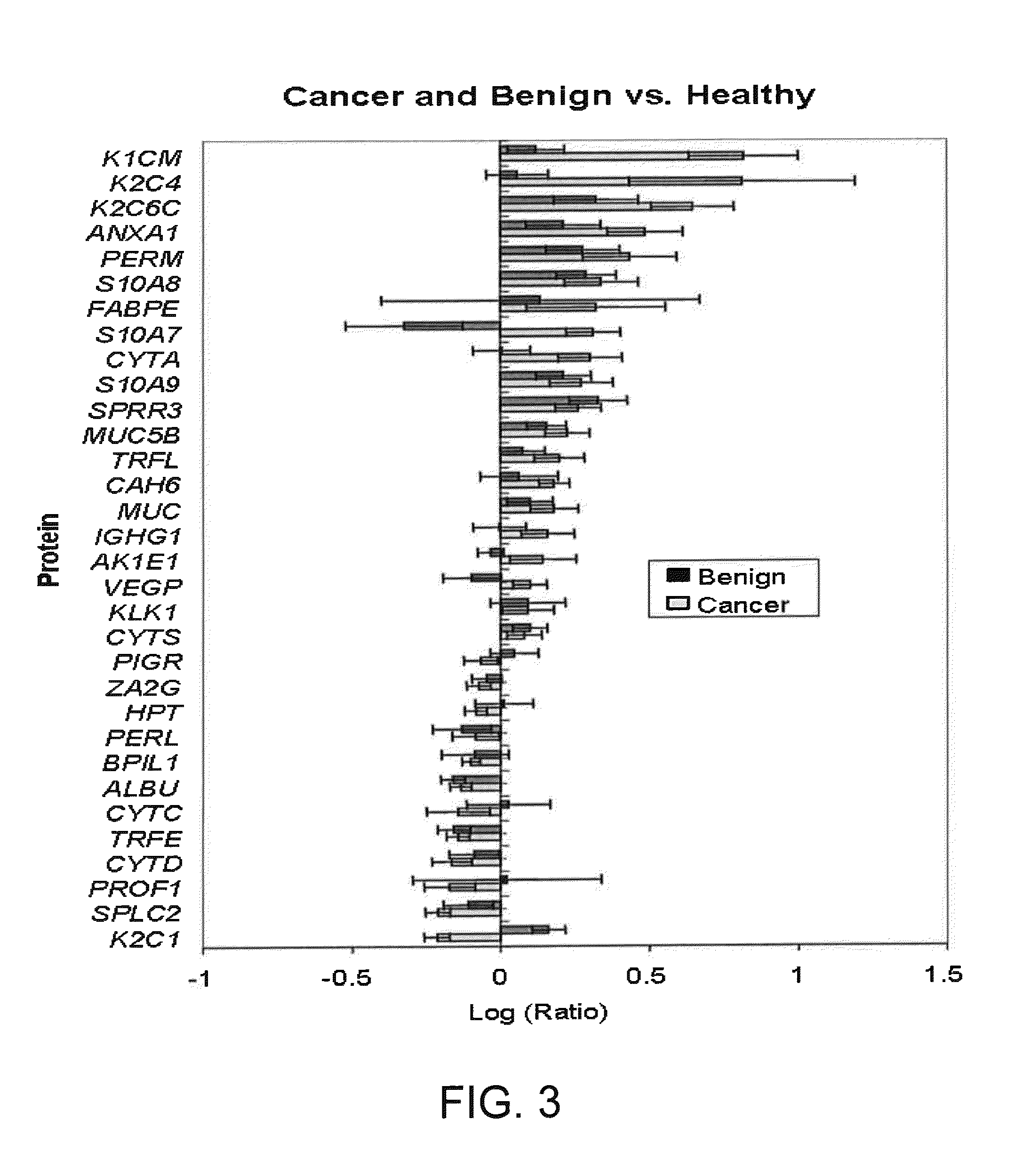Salivary Protein Markers for Detection of Breast Cancer
a breast cancer and protein marker technology, applied in the field of methods and compositions for diagnosing breast cancer, can solve the problems of lack of sensitivity in detecting cancerous lesions in younger women, large false positive and false negative percentage, etc., and achieve the effect of increasing or decreasing increasing or reducing the risk of breast cancer
- Summary
- Abstract
- Description
- Claims
- Application Information
AI Technical Summary
Benefits of technology
Problems solved by technology
Method used
Image
Examples
example 1
Salivary Protein Analyses With iTRAQ™
[0124]Saliva samples are thawed and immediately centrifuged to remove insoluble materials. The supernatant is assayed for protein using the Bio-Rad protein assay (Hercules, Calif., USA) and an aliquot containing 100 μg of each specimen is precipitated with 6 volumes of −20° C. acetone. The precipitate is resuspended and treated according to the iTRAQ™ manufacturer's instructions. Protein digestion and reaction with iTRAQ™ labels are carried out according to the manufacturer's instructions (Applied Biosystems, Foster City, Calif.). Briefly, the acetone precipitable protein is centrifuged in a table top centrifuge at 15,000×g for 20 minutes. The acetone supernatant is removed and the pellet resuspended in 20 μl dissolution buffer. The soluble fraction is denatured and disulfides reduced by incubation in the presence of 0.1% SDS and 5 mM TCEP (tris-(2-carboxyethyl)phosphine)) at 60° C. for one hour. Cysteine residues are blocked by incubation at roo...
example 2
Use of Salivary Biomarkers to Differentiate Non-Cancerous Tissue, Benign Tumor, and DCIS in a Test Sample
[0141]In some embodiments, one or more salivary biomarkers are used to differentiate non-cancerous breast tissue, benign breast tumor and ductal carcinoma in situ of the breast by analyzing the salivary proteome of an individual suspected of having breast cancer, as described above. One or more of the protein biomarkers identified in Tables 3 and 4 are identified and quantified in the test patient's saliva specimen, and the resulting values are then compared to a biomarker reference panel, which is developed in accordance with the above-described procedure. The biomarker reference panel is made up of a group of the same saliva protein constituents developed using DCIS, benign tumor and healthy, non-cancerous (i.e., tumor free) control group populations. Each constituent has associated with it a range of concentration values, a mean concentration, and statistical error range. Rece...
example 3
[0143]In one embodiment of a screening procedure, the biomarker Q9UBC9 / SPRR3 (encoded by GenBank Accession No. Q9UBC9 Gene ID. SPRR3), indicated in Tables 3 and 4, is quantitated in the saliva of an individual to diagnose a breast cancer, using the above-described saliva sample preparation and analysis procedures, or equivalent methods. The detected level or value of the biomarker is then compared to reference values of the biomarker in the saliva of individuals with breast tumors (either benign fibroadenomas or DCIS). By comparison of the individual's marker value to the reference value (or range of values), a differential diagnosis of the patient is determined, to differentiate between breast cancer and breast cancer-free condition.
[0144]In a modification of this procedure, the individual's salivary level of the Q9UBC9 / SPRR3 biomarker is additionally compared to respective reference values in the saliva of individuals with DCIS and of individuals with benign breast tumor (i.e., fi...
PUM
| Property | Measurement | Unit |
|---|---|---|
| dissociation constant | aaaaa | aaaaa |
| dissociation constant | aaaaa | aaaaa |
| dissociation constant | aaaaa | aaaaa |
Abstract
Description
Claims
Application Information
 Login to View More
Login to View More - R&D
- Intellectual Property
- Life Sciences
- Materials
- Tech Scout
- Unparalleled Data Quality
- Higher Quality Content
- 60% Fewer Hallucinations
Browse by: Latest US Patents, China's latest patents, Technical Efficacy Thesaurus, Application Domain, Technology Topic, Popular Technical Reports.
© 2025 PatSnap. All rights reserved.Legal|Privacy policy|Modern Slavery Act Transparency Statement|Sitemap|About US| Contact US: help@patsnap.com



